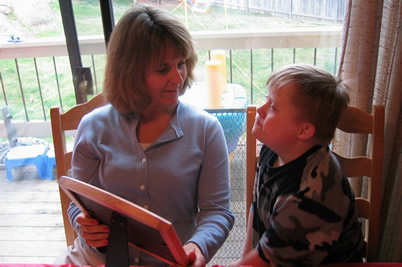Auditory Impairments
 Sixty to 80% of children
with Down syndrome have hearing impairments at some point during their childhood.
As many of these youngsters are unable to identify and/or communicate this impairment,
it’s very important that professionals working with this population diligently
screen for hearing loss. The next section of this program includes some specific
recommendations for the evaluation of hearing function at different ages.
Sixty to 80% of children
with Down syndrome have hearing impairments at some point during their childhood.
As many of these youngsters are unable to identify and/or communicate this impairment,
it’s very important that professionals working with this population diligently
screen for hearing loss. The next section of this program includes some specific
recommendations for the evaluation of hearing function at different ages.
- Some individuals with
Down syndrome have sensorineural hearing loss, others have a conductive hearing
loss because of frequent otitis media (infections of the middle ear), and
a few have both types of hearing loss. Hearing aids can be extremely beneficial
for many of these children, and nurses can serve a valuable role in coaching
parents to encourage appropriate hearing aid use in their children.
- Nurses working with children
with Down syndrome may be the first clinicians to detect subtle impairments
in vision and hearing, and make referrals for evaluation and treatment. Impaired
hearing and vision can contribute to behavioral problems, social isolation,
and speech and language issues. Some impairments, such as sensorineural hearing
loss, may not be correctable.
- Nurses familiar with
the child’s living situation can make valuable recommendations for telephones
with amplifiers or enlarged buttons, headsets for use while watching television
or playing CD’s, and other adaptive strategies.
Instant
Feedback:
Once
they are identified, any of the hearing problems found in children with
Down
syndrome can be corrected.
Visual
Impairments
Children with Down syndrome
are at significant risk for a number of vision disorders, including the following:
- Congenital cataracts
- Strabismus (crossed-eyes)
- Nearsightedness or farsightedness
- Blepharitis (inflammation
of the eyelids)
- Conjunctivitis
Because parents of children
with Down syndrome are often dealing with a number of medical and developmental
problems, visual impairments can be overlooked. Without good vision, the child
is at much higher risk for developmental delays and can be more isolated from
the environment. Nurses can help identify vision problems, and should encourage
parents to follow the evaluation recommendations outlined in the next section
of this program.
Instant
Feedback:
Cataracts
are common in older adults with Down syndrome, but are not an issue in
early childhood.
 Sixty to 80% of children
with Down syndrome have hearing impairments at some point during their childhood.
As many of these youngsters are unable to identify and/or communicate this impairment,
it’s very important that professionals working with this population diligently
screen for hearing loss. The next section of this program includes some specific
recommendations for the evaluation of hearing function at different ages.
Sixty to 80% of children
with Down syndrome have hearing impairments at some point during their childhood.
As many of these youngsters are unable to identify and/or communicate this impairment,
it’s very important that professionals working with this population diligently
screen for hearing loss. The next section of this program includes some specific
recommendations for the evaluation of hearing function at different ages.